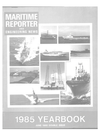
Page 97: of Maritime Reporter Magazine (June 1985)
Read this page in Pdf, Flash or Html5 edition of June 1985 Maritime Reporter Magazine
lustrations, this impressive bro- chure unfolds to reveal a large re- production of the DataBridge-7
ARPA console. One of the major breakthroughs in modern naviga- tion has been the development of the automatic plotting aid (ARPA), and now at the touch of a switch, an officer can insure accurate and auto- matic plotting and logging through the additional features provided for the system. The main innovation has focused on extending the sys- tem's unique radar map overlay functions by adding unlimited stor- age capacity, an X/Y track plotter, and datalogger. Another optional feature allows radar maps to be sta- bilized with the aid of navigation data where fixed points for radar tracking are missing. Norcontrol's
DataBridge-7 is a third-generation
ARPA that acquires and tracks up to 50 radar targets and continuously displays collision avoidance data on the most threatening 20. It will sound a collision-warning alarm whenever any of these targets ex- ceed user-specified values for clos- est point of approach and time to closest point of approach. As a colli- sion-avoidance system, DataBridge- 7 meets or exceeds IMO recommen- dations and USCG and Maritime
Administration standards.
Circle 12 on Reader Service Card • DataChief-7 Monitoring and
Control System—This eight-page color publication explains that the chief function of DataChief is to monitor the running condition of the ship's main propulsion machin- ery. In addition, the system moni- tors the main machinery's second- ary parameters and controls motors, pumps, etc., to ensure optimum run- ning efficiency. The DataChief-7 is based on microprocessor technology and satisfies the classification soci- eties' requirements for unmanned operation of engine rooms for both diesel and steam-turbine ships. A ring data highway links a number of dedicated distributed microproces- sors to a central control station, with the choice of local or central readout facilities. Standardized modules together with the ring data highway minimizes the possibility of system failure and ensures a high degree of redundancy without the need for extra components. Full sys- tem control is achieved from one or more operator stations via a variety of displays and functional key- boards.
Circle 14 on Reader Service Card • Tank Level & Draught Gauging for Ship and Offshore—The de- mands for quick loading and dis- charging of cargo reduce the time available for efficient cargo plan- ning and safety precautions. This eight-page color brochure explains that Norcontrol's cargo handling systems provide continual and accu- rate information on level measure- ment for cargo ballast and fuel tanks, on-line assessment of ship stability, vessel list and trim, hull sheer force and bending moment, etc., as well as providing cargo re- ports including damage stability.
Circle 167 on Reader Service Card •>•
These systems were first introduced in 1971 and have been installed onboard tankers, bulk carriers and
RO/RO-container ships.
Circle 15 on Reader Service Card • Vessel Traffic Management
Systems—Norcontrol's vessel traf- fic management systems significant- ly reduce the risk of ship collisions with offshore oil and gas installa- tions, both on the surface and sub- sea, according to this 12-page color brochure on vessel traffic manage- ment for coasts and ports. The traf- fic surveillance system provides the operator with a detailed presenta- tion of the traffic situation within the actual surveillance area together with continuous information on all vessels' positions, course, speed, range and bearing. Surveillance of traffic is undertaken centrally and the system may be tailor-made for offshore production fields, harbor areas and critical channels. It is based upon signals from a virtually unlimited number of radars, and the traffic situation thus detected is presented on the operator's console together with programmed informa- tion such as subsea installations, traffic lanes, boundary lines, an- choring areas, etc., and speed and course vectors for moving targets.
All data concerning target move- ments may be recorded for later playback. Extensive warning func- (continued from page 96)
If our insurance broker can't cut your marine/ oil & gas risks, our safety engineers can.
You'll get the most cost-efficient coverage possible from the marine/oil & gas insurance specialists at Wm.
Keith Hargrove. We dig into the reasons behind the numbers and help our clients identify potential acci- dents in their operations-services that go beyond those of the ordinary insurance broker.
A computer program developed specifically for analyzing the claims of marine and oil & gas opera- tors helps us pinpoint problem areas in their oper- ations, show them how much they're spending on deductibles and reduce overall costs.
We have marine and oil & gas safety engineers on staff-a unique service among insurance brokers. Our safety and loss control studies have helped numerous clients reduce personal, injuries and equipment down- time-in addition to lowering the cost of their coverage.
Most important of all, we'll be there when you need us-because we're committed to providing our clients with highly personalized service. If you'd like us to review your marine or oil & gas coverage, please contact Wm. Keith Hargrove. 1 w:H
Wm. Keith Hargrove, Inc.
INSURANCE/RISK MANAGEMENT
CONSULTANTS 1300 Post Oak Blvd.
Suite 2050
Houston, Texas 77056 (713) 621-7428
Telex: 774522-WKH HOU

 96
96

 98
98
